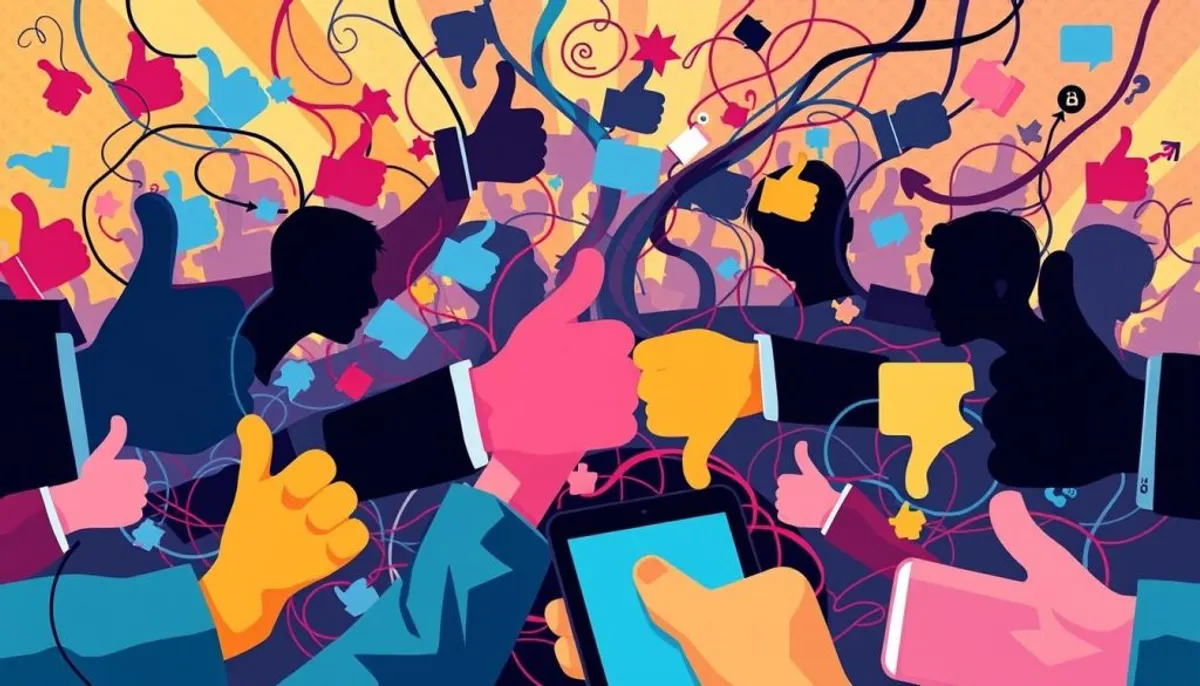The culture of cancellation, or “cancel culture”, is sparking lively debate in France. This phenomenon, emerging from social media, raises controversies. It came to light in 2020, following the death of George Floyd, in connection with social justice movements.
Cancel culture aims to publicly expose statements or actions deemed problematic. It can lead to the boycott of personalities, causing significant damage to them.

The case of Sandra Muller illustrates the legal risks inherent in this phenomenon. She, the initiator of the hashtag #BalanceTonPorc, was convicted of defamation. This case highlights the complexity between denunciation and cyberbullying.
To better grasp this complex subject, the book “Who Cancels What?” offers an in-depth analysis in 48 pages. Written by an author who won the Femina award in 2011, it explores the mechanisms and stakes of cancel culture.
How to Define Cancel Culture
The definition of cancel culture is constantly evolving. Born in the United States, it has rapidly spread in the Francophone world. It involves a social boycott aimed at publicly excluding a person or entity for statements or actions deemed unacceptable.
Origins of the Term and Historical Context
The term “cancel culture” first appeared in 2017. It emerged in the context of social justice and civil rights movements. The popularization of this phenomenon is linked to the rise of social media platforms such as Facebook, Twitter, and Instagram.
Evolution of the Concept in the Francophone World
Cancel culture has quickly established itself in the Francophone world. It is seen as a means of holding individuals and institutions accountable. However, its application can lead to excesses. Cases like those of J.K. Rowling or Johnny Depp demonstrate its growing impact.
Differences Between Boycott and Cancel Culture
The traditional boycott and cancel culture differ significantly. A comparative table highlights them:
| Boycott | Cancel Culture |
|---|---|
| Targeted at products or services | Aims at individuals or entities |
| Generally time-limited | Can have lasting consequences |
| Objective: behavior change | Objective: social exclusion |
| Limited spread | Viral spread on social media |
Cancel culture is characterized by its viral spread and its goal of total exclusion. It can cause severe damage, ranging from job loss to reputation destruction.
The Mechanisms of Cancel Culture on Social Media
Social media is essential in the expansion of cancel culture. This online criticism spreads rapidly through digital tools and unique group dynamics.
The Role of Hashtags and Virality
Hashtags play a crucial role in virality on social media. They allow messages to be grouped around a common topic, thus facilitating the rapid dissemination of a controversy. Virality relies on the mass sharing of content, amplifying the impact of cancel culture.
The Impact of Algorithms on Propagation
The algorithms of social platforms favor the spread of controversies. They highlight content that generates the most interactions, whether positive or negative. This mechanism contributes to the increased exposure of controversial topics related to cancel culture.

Online Group Dynamics
On social media, specific group dynamics form around controversies. These interactions can sometimes lead to cyberbullying. The notion of online community is ambiguous, oscillating between solidarity and mob mentality. In this context, an assessment of corporate culture can be crucial for understanding individual behaviors within these groups.
| Element | Impact on Cancel Culture |
|---|---|
| Hashtags | Grouping and visibility of messages |
| Virality | Rapid dissemination of controversies |
| Algorithms | Highlighting controversial content |
| Group Dynamics | Risk of cyberbullying |
The Main Targets of Cancel Culture
Cancel culture targets personalities accused of unacceptable behaviors. These controversies often erupt on social media, influencing consumers and culture. They affect both public figures and anonymous individuals.
Frequent targets include:
- Celebrities accused of discriminatory remarks
- Politicians involved in scandals
- Companies with contested practices
- Ordinary individuals for controversial actions
- The American cultural hegemony that influences social behaviors
The accusations often revolve around social justice issues. They concern sexism, racism, or homophobia. An isolated act or a controversial opinion can trigger a wave of virulent criticism.
| Personality | Accusation | Consequence |
|---|---|---|
| Justine Sacco | Controversial tweet | Termination |
| Christophe Girard | Funding Gabriel Matzneff | Resignation |
| Taylor Swift | Dispute with Kanye West | Temporary boycott |
These examples show the diversity of targets and the extent of the controversies. The effects vary according to the severity of the accusations and the public's reaction.
The Psychological and Social Consequences
Cancel culture has profound effects on individuals, impacting both their personal and professional lives. The impact is often devastating, altering the existence of those who fall victim to it.
Impact on “Cancelled” Individuals
Victims of cancel culture experience endless harassment. They find themselves isolated, losing their network and seeing their reputation collapse. This process creates enormous stress, permanently altering their self-esteem.
Effects on Mental Health
The psychological consequences are severe. Anxiety, depression, and sleep disorders are common reactions. The fear of public shame and self-censorship lead to withdrawal. Some develop post-traumatic stress syndrome.
Professional Repercussions
Professionally, being “cancelled” can be catastrophic. The loss of contracts, followers, or career opportunities is frequent. The impact varies according to notoriety, but is often devastating, affecting both anonymous individuals and public figures.

| Aspect | Consequences |
|---|---|
| Social | Isolation, loss of network |
| Psychological | Anxiety, depression, stress |
| Professional | Loss of contracts, decrease in income |
| Reputation | Lasting damage to image |
The Political Dimension of the Phenomenon
Cancel culture is deeply embedded in the current political debate. This phenomenon, born on social media, has gained considerable momentum in France. It reflects a form of modern activism that divides public opinion and exacerbates the polarization of discussions.
Supporters of cancel culture see it as a means to fight against discrimination and give a voice to minorities. Critics, on the other hand, denounce it as a threat to freedom of expression. This tension is particularly evident in universities, where conferences are sometimes canceled due to controversies.
The case of historian Alain Finkielkraut, removed from a show after controversial remarks, illustrates the scope of this phenomenon. It raises questions about the limits of public debate and the place given to divergent opinions.
| Aspect | Supporters | Opponents |
|---|---|---|
| Vision | New form of activism | Threat to freedom of expression |
| Objective | Fight against discrimination | Preserve the pluralism of ideas |
| Perceived Impact | Rebalancing of public debate | Exacerbation of polarization |
Cancel culture thus reveals the tensions within our society. It highlights the challenges of coexistence in a world where political debate is now largely played out online. The management of corporate culture is also a crucial aspect to consider in this context.
The Limits Between Constructive Criticism and Cyberbullying
The distinction between constructive criticism and cyberbullying is often ambiguous in the context of the online debate. Understanding this ambiguity is essential for promoting positive interactions on the internet.
Differentiating Debate from Lynching
The online debate can quickly escalate into cyberbullying. In 2020, journalist Bari Weiss was a victim of “cancel culture” for her divergent opinions. This case highlights the dangers of censorship associated with this phenomenon.
Possible Excesses
Constructive criticism can sometimes be misinterpreted. The case of Mehdi Meklat, whose racist and homophobic tweets were revealed, shows how a career can be ruined by past remarks. It is crucial to distinguish between legitimate accountability and online lynching. The testimonies of those who have experienced these situations are essential for better understanding the stakes.
Constructive Alternatives
To avoid excesses, more positive approaches are emerging. The “call-in”, which involves addressing with empathy, offers an alternative to cyberbullying. This method allows for addressing issues more constructively, without resorting to public humiliation.
| Approach | Characteristics | Impact |
|---|---|---|
| Constructive Criticism | Respectful feedback, focused on improvement | Encourages dialogue and progress |
| Cyberbullying | Personal attacks, online intimidation | Psychological damage, social isolation |
| Call-in | Empathetic communication, education | Promotes mutual understanding |
The Role of Traditional Media
Traditional media occupy a complex position in the context of cancel culture. Their way of handling controversies arising from social media can significantly influence the consequences for the individuals involved. This influence can be both amplified and diminished, depending on the media treatment.
A recent study reveals that 64% of consumers are influenced by a brand's position on social issues when making purchasing or boycott decisions. The media play a decisive role in shaping public opinion by relaying these positions.
The treatment of cancel culture cases by traditional media can have profound impacts:
- Amplification of controversies
- Critical insight into the phenomenon
- Influence on the reputation of targeted individuals or brands
Data shows that 56% of consumers suspect that some companies engage in “woke-washing” to boost their sales. The media play a crucial role in analyzing and denouncing these strategies.
| Impact of Media | Consequences |
|---|---|
| Relay of controversies | Amplification of cancel culture |
| Critical analysis | Better understanding of the phenomenon |
| Fact-checking | Combatting misinformation |
In the face of these challenges, traditional media must seek a balance. They must inform without contributing to the escalation of controversies. Their role is crucial in providing nuanced insight into cancel culture and its effects on society.
Conclusion
Cancel culture, a complex and controversial phenomenon, has profoundly marked our social and media landscape. Its rapid evolution, illustrated by its selection as the “word of the year” in 2020 by the Oxford dictionary, attests to its considerable impact. The assessment of this practice remains mixed, between denunciation of injustices and risks of excesses.
The perspectives of cancel culture raise numerous questions. On one hand, it has helped shed light on important issues, such as the #DisruptTexts movement in the United States. On the other hand, incidents like the cancellation of “The Suppliants of Aeschylus” in France in 2019 show its potential limits. The challenge is to find a balance between freedom of expression and social responsibility.
The evolution of cancel culture will largely depend on our ability to foster constructive dialogue. Social media, catalysts of this phenomenon, could become spaces for more nuanced debate. In France, where its impact remains moderate, the emphasis on education and critical thinking could offer a promising alternative. This would allow sensitive topics to be addressed in a more balanced and thoughtful manner.
RelatedRelated articles


